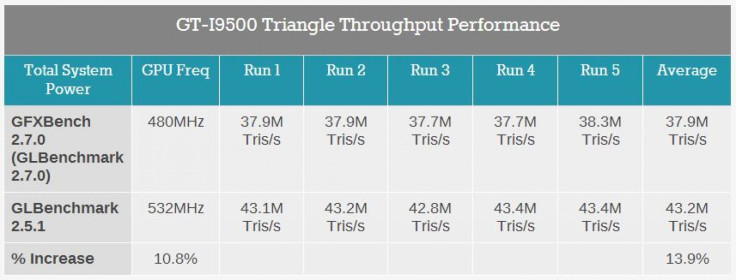Samsung, It's Claimed, Has Been Found Tampering Galaxy S4 Benchmarks By Using Performance-Enhancing Code To Beef Up Test Scores

In a desperate move to beat its rivals in the so-called smartphone wars, Samsung (KRX:005935) has manipulated certain benchmark results of its Galaxy S4 by using performance-enhancing code to increase the handset’s clock speed, reports claim.
After a user, @AndreiF, made the claims in a forum on Beyond3D, a 3D-graphics website, specialists at AnandTech dug around the internals of the Galaxy S4 and confirmed that Samsung deliberately attempted to get the Galaxy S4 to clock a higher GPU/CPU speed during some benchmark tests, while bringing it down to lower speeds for daily usage.
Here’s what the original claim at Beyond3D said:
"I'm currently doing GPU overclocking and voltage control in the kernel for the 5410/i9500 and was screwing around with what was supposed to be a generic max limit only to be surprised by what it actually represents.
"This GPU does not run 532MHz; that frequency level is solely reserved for Antutu and GLBenchmark* among things. The GPU on non-whitelisted applications is limited to 480MHz. The old GLBenchmark apps for example run at 532MHz while the new GFXBench app which is not whitelisted, runs at 480MHz."
Let’s simplify this.
Samsung claims that the Exynos 5 Octa (5410) chip featured in the international variant of the Galaxy S4 is capable of running at up to 533MHz. But, according to the claim in question, the handset never used that clock speed as Samsung was only exposing its 533MHz GPU clock to certain benchmarks, while other apps and games were limited to 480MHz.
“Running any games, even the most demanding titles, returned a GPU frequency of 480MHz - just like @AndreiF alleged. Samsung never publicly claimed max GPU frequencies for the Exynos 5 Octa (our information came from internal sources), so no harm no fouls thus far,” the AnandTech report said.
“Firing up GLBenchmark 2.5.1 however triggers a GPU clock not available elsewhere: 532MHz. The same is true for AnTuTu and Quadrant.”

While the Beyond3D forum post focused only on GPU performance, hardware experts at AnandTech revealed that Samsung used similar tactics on the Galaxy S4's CPU performance as well.
The experts used GLBenchmark 2.5.1 and found that the SoC switches to the ARM Cortex A15 cluster, with a default frequency of 1.2GHz, which never dropped even when the device was left idle at the menu screen of the benchmark.
However, when the experts used GFXBench 2.7, the SoC was on the Cortex A7s running at 500MHz. Therefore, it appeared that the higher CPU speed was meant only for the GLBenchmark 2.5.1 benchmark test.
“A quick check across AnTuTu, Linpack, Benchmark Pi, and Quadrant reveals the same behavior. The CPU governor is fixed at a certain point when either of those benchmarks is launched,” the report said.
In addition to the Exynos 5 Octa version of the Galaxy S4, the Qualcomm version of the smartphone was also found displaying similar behavior on the CPU side.
The latest claims suggest Samsung might be exerting its engineering efforts on gaming benchmark results than on improving user experience -- a practice that could mislead potential buyers who tend to compare benchmark scores on multiple handsets before settling on a particular product.
© Copyright IBTimes 2025. All rights reserved.






















